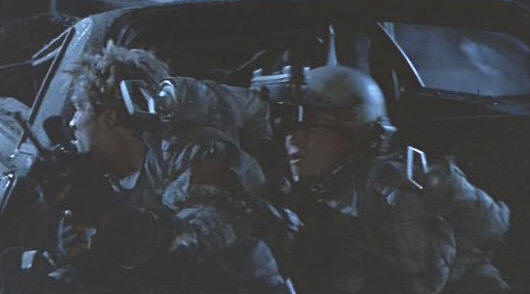
M83 Pincer Grenade (heavy canister charge
arrayed anti-tank mine)
"Then it came into
full view- a blast-scarred chrome Leviathan on treads. The huge
under-slung turret guns pivoted in their arc, pounding the surrounding ruins
into flat rubble.
Reese un-strapped a
satchel from Ferro's back and quickly pulled out one of the cylindrical
anti-tank mines and laid it on his knee. Ferro followed Reese's
lead. They could hear the H-K swinging on its axis and coming closer.
Remove the dust
plug. Reese steadied his breathing. Test the circuit. The
huge monster was coming into range. Disengage the safety ball.
Reese's hands were sweating, slipping against the stainless-steel casing.
Grasp the handle and twist, clockwise, from SAFE to ARMED. The ring
around the top half of the mine lit up. it was
hungry.
Reese peered over the edge
of the wall. The H-K was only a few yards to the front, the roar of its
engines building to a fever pitch. He stared into the treads, locked his
eyes on them.
Now die, motherfucker!
He leaped up and
straight-armed the mine into the Leviathan's path. One of its treads
rolled right over the bomb. The monster paused, guns and searchlights
swiveled. The head turned, ponderously."
-Frakes and Wisher,
"The
Terminator"

Sgt. Reese and Cpl. Ferro, the last surviving member of Reese's
twelve-man
squad, prepare to take out a heavy tracked HK with
their M83 canister charges.
The M83 utilized an
advanced binary stabilized liquid explosive (BINASLEX) device combining two
inherently stable liquid high explosive mediums, stored under high pressure,
into a single volatile solution. The device measured half a meter in length and
a quarter meter in diameter, weighing exactly 5 kilos. A web harness
constructed of nylon allowed a soldier to carry two of the M83HCCs slung over
their shoulder in a quick release mount.
If more than
this number were carried, the extra units quickly became clumsy and cumbersome
to wield or carry, especially in confined spaces among the debris fields or if
the soldier was actively being pursued.

M83HCC being armed prior to throwing. The subtle flash and fading glow was a
byproduct of the two inert binary elements becoming a radical solitary element.
The M83HCC was called a "pincer" grenade because of its arming sequence and the fact that most of the M83HCCs were thrown rather than placed as an anti-armor device. The activation of the M83HCC involved a "pincer" action which forced two inert binary elements together to form a radical solitary element that rapidly built in chemical explosive power, a mixture where the whole was greater than the sum of the parts, by several factors.
The M83HCCs arming
sequence is designed to be simple and straight-forward; a large handle on the
top of the canister is pulled 5cm upward and twisted 180 degrees in a clockwise
rotation to afford a 10 second mixture rate of the two binary explosive
liquids. Twisting the handle ten degrees further allows more time in mixing, in
5 second increments, up to a full minute. Notches on the rim of the arming cap
allow the user to dial-in the correct arming time sequence using the arming
handle, even if by feel alone. Pulling and turning the handle arms the M83 HCC
by directing the two liquid explosives to flow from separate holding tubes into
a central mixing chamber. A warning light on the rim of the HCC glows bright
green and then slowly grows dim as the mixture is completed. Detonation is by a
high amperage electric current directed into the central mixing tank as soon as
both holding tubes are empty and the central tank reads full. The
detonating current is supplied by an integral battery which may be kept charged
by a special rack which holds the M83HCCs. The battery has a shelf life
of 5 years without recharging. M83HCCs with depleted batteries may be
charged and used successfully even after years of being uncharged, as long as
the internal battery has not been damaged or become corroded. Replacement
batteries are available in most armorer's
kits.
The two liquids, though
stable in each separate holding tank, become electrically volatile when mixed.
A full 4 kilos of liquid high explosive is produced (2 kilos of each material, LiqEx A and LiqEx B) in the
central mixing chamber. Each kilo of BINASLEX, when properly mixed, is the
equivalent of 5 kilos of C-4 plastique. The M83HCC
was a common demolition device used by the military during the last War. it was usually placed against a structure that was to be
demolished and then activated for maximum fusing, allowing the human operator a
wide margin of safety in order to clear the blast radius. A special
cone-shaped filter could be attached to the device to tamp the charge and
direct the energy of the explosive into a shaped ("
During the War, the
humans found that the M83 was well suited for cracking the heavy armor of SKYNET's larger ground units. A well placed charge,
often thrown at the last second from protective cover, could penetrate the hyperalloy armor belt which were less thick on the
underbody, the compression wave being capable of cracking the hyperalloy combat case where it was thinnest, allowing the
high velocity plasma jet to enter the fighting body and wreck the internal
components, often setting up sympathetic internal explosions and wrecking the
larger units. Feedback damage from the initial explosion, as well as
shrapnel and fragmentation in the form of anything the explosion can sweep up
off the ground, can be lethal to the user if the user is not properly shielded
or has not taken cover. Other Resistance units have installed trip wires,
remote laser communicator detonators and even pressure switches to already
pre-armed M83HCC units in order to produce effective ambush traps in advance of
known Machine patrol routes.
_________________________